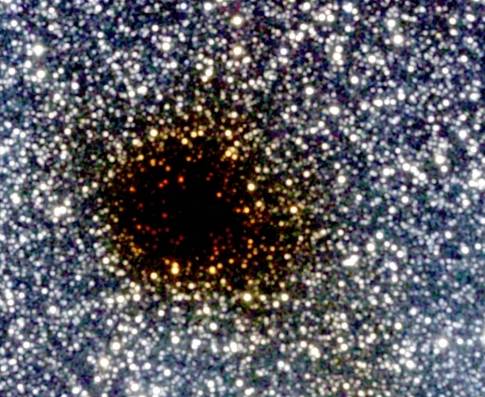Stars, Dust, and Gas Near Antares.
Image Credit & Copyright: Mario Cogo (Galax Lux)
Why are the colors the way they are in the APOD?
1) The
yellow Antares reflection nebula. Antares is, despite being called a red supergiant, not actually a red star. Its B-V index is around +1.9, which makes it a yellow-orange star. (If you want a redder star, check out
Mu Cephei, with a B-V index of cirka +2.2, or, better yet, carbon star
T Lyrae, with a variable B-V index which is almost always larger than +5.)
So Antares isn't actually a red star, but yellow-orange. Its reflection nebula is even less orange and more yellow than the star itself, because the dust particles in reflection nebulas preferentially scatter shorter wavelengths. The Antares reflection nebula is by far the largest of the yellow reflection nebulas visible in the sky.
2) The
blue Rho Ophiuchi reflection nebula. The star Rho Ophiuchi itself is a binary star made up of two stars of spectral class B2, which is ideal for creating a blue reflection nebula. Such stars pump out huge amounts of blue and violet photons, while at the same time just falling short of emitting enough ultraviolet photons to ionize an emission nebula. In the case of Rho Ophiuchi, there is just the right amount of dust behind the stellar pair to scatter their blue light back at us. The Rho Ophiuchi nebula is one of the largest blue reflection nebulas in the sky.
3) The
pink Sigma Scorpii nebula. Sigma Scorpii is another binary star, and I have seen many different suggestions as to what their spectral types are: B1III, B2III+O9.5V, and O9.5V+B7V. Well, whichever combination is the correct one, Sigma Scorpii definitely produces more ultraviolet photons than Rho Ophiuchi does, and therefore Sigma Scorpii ionizes a pink emission nebula. This is to say that a sufficiently large number of energetic photons from Sigma Scorpii knocks electrons in hydrogen atoms in the surrounding gas cloud into a "higher orbit" around their protons, or rather, the energetic photons knock electrons into a higher electron shell. As the electron "falls down" again, it rids itself of the extra energy it gained when it was kicked into another electron shell, and it does so by emitting a photon of 656.281 nm. This is the wavelength of hydrogen alpha, which is
very red. So why does the emission nebula look pink when all those "kicked-upstairs-and-falling-down" electrons emit all that red light?
The pink color is caused by the attenuation of the very red 656 nm light by the simultaneous emission of
bluish cyan hydrogen beta 486 nm photons, emitted by electrons that were knocked "two levels up" by extra energetic photons. But please note that Sigma Scorpii is also lighting up a blue reflection nebula, because there is a significant amount of dust particles in the gas cloud near Sigma Scorpii, and the blue reflection nebulosity further attenuates the red light of hydrogen alpha.
4) The very
dark brown dust tendrils. Here the dust particles are sufficiently numerous to (almost) completely block light from behind them. The intrinsic color of the dust grains themselves is dark brown, so we see the color of the dust itself in these dark tendrils.
5) The
light brown or
orange patches. Here dust partly blocks and reddens light from behind.
Look at the picture at right. You can see that the edges of the dark cloud allows yellow light to pass through, and the starlight looks yellower that the surrounding star field. Further in, the yellow light is also blocked, and only orange light can penetrate. Then only red light is let through, until finally all light is blocked by the dust cloud.
The orange and light brown patches in the Antares-Rho Ophiuchi cloud complex are places where some light is blocked by dust, and the light that passes through has been reddened. Actually the rather pale
yellow color of the Antares nebula is made into a deeper, more orange shade of
yellow in places by dust reddening.
Ann
 Stars, Dust, and Gas Near Antares
Stars, Dust, and Gas Near Antares

